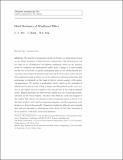Fluid mechanics of Windkessel effect
Author(s)
Mei, C. C; Zhang, J.; Jing, H. X
Download11517_2017_1775_ReferencePDF.pdf (286.3Kb)
Publisher Policy
Publisher Policy
Article is made available in accordance with the publisher's policy and may be subject to US copyright law. Please refer to the publisher's site for terms of use.
Terms of use
Metadata
Show full item recordAbstract
Abstract
We describe a mechanistic model of Windkessel phenomenon based on the linear dynamics of fluid-structure interactions. The phenomenon has its origin in an old-fashioned fire-fighting equipment where an air chamber serves to transform the intermittent influx from a pump to a more steady stream out of the hose. A similar mechanism exists in the cardiovascular system where blood injected intermittantly from the heart becomes rather smooth after passing through an elastic aorta. In existing haeodynamics literature, this mechanism is explained on the basis of electric circuit analogy with empirical impedances. We present a mechanistic theory based on the principles of fluid/structure interactions. Using a simple one-dimensional model, wave motion in the elastic aorta is coupled to the viscous flow in the rigid peripheral artery. Explicit formulas are derived that exhibit the role of material properties such as the blood density, viscosity, wall elasticity, and radii and lengths of the vessels. The current two-element model in haemodynamics is shown to be the limit of short aorta and low injection frequency and the impedance coefficients are derived theoretically. Numerical results for different aorta lengths and radii are discussed to demonstrate their effects on the time variations of blood pressure, wall shear stress, and discharge.
Graphical Abstract
A mechanistic analysis of Windkessel Effect is described which confirms theoretically the well-known feature that intermittent influx becomes continuous outflow. The theory depends only on the density and viscosity of the blood, the elasticity and dimensions of the vessel. Empirical impedence parameters are avoided
Date issued
2018-01-08Department
Massachusetts Institute of Technology. Department of Civil and Environmental EngineeringPublisher
Springer Berlin Heidelberg